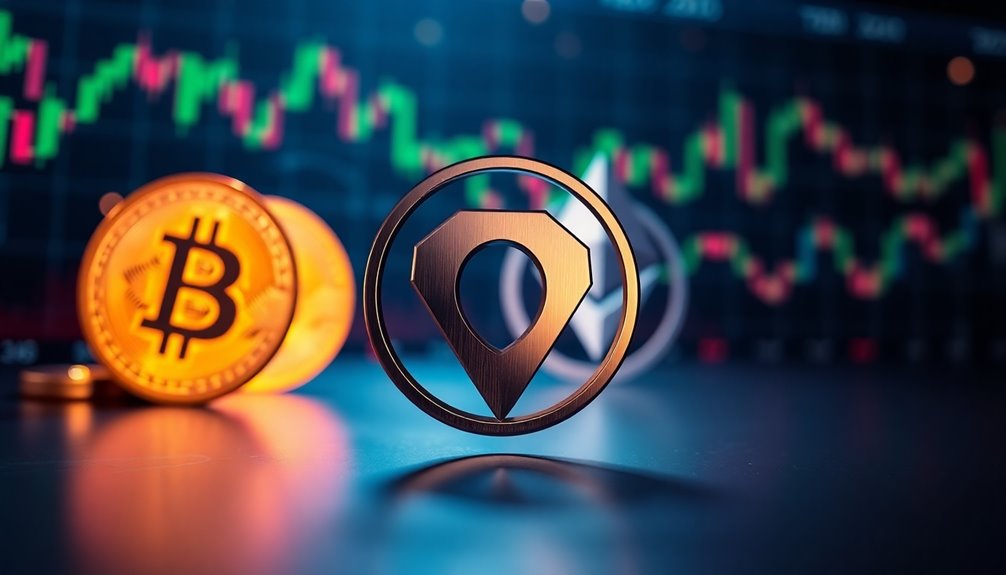QTUM is an innovative blockchain that bridges the worlds of Bitcoin and Ethereum. It combines the best features of both, offering smart contract capabilities and a unique consensus mechanism that includes Proof-of-Work and Proof-of-Stake. This allows for efficient transaction validation, with speeds up to 100 transactions per second. Qtum not only aims for decentralization but also adapts well to evolving regulatory standards. With its robust architecture, it promises enterprise solutions that enhance operational efficiency. If you're curious about how Qtum's unique features can impact the future of blockchain technology, there's much more to uncover.
Qtum's Unique Consensus Mechanism

Qtum's unique consensus mechanism sets it apart in the blockchain landscape, as it effectively combines the strengths of both Proof-of-Work (PoW) and Proof-of-Stake (PoS) systems.
This Mutualized Proof of Stake (MPoS) approach reduces competition for computational power, making it easier for you to participate without needing expensive hardware.
You'll appreciate how it enhances smart contract functionality while minimizing risks associated with "junk contracts" and attacks.
Moreover, the network promotes decentralization, ensuring a robust distribution of nodes. Additionally, the Qtum ecosystem supports decentralized applications (dApps) that are powered by the QTUM token, further expanding its use cases. These dApps leverage the unique capabilities of the QTUM blockchain, enabling developers to create innovative solutions across various industries. The qtum protocol features and benefits include its combination of both Bitcoin’s robust security and Ethereum’s smart contract functionality, providing a versatile platform for developers. As more projects adopt the Qtum framework, the ecosystem continues to grow, offering users greater opportunities and enhancing the overall utility of the QTUM token.
With validators chosen based on their QTUM stakes, you'll find transaction validation both efficient and speedy, processing up to 100 transactions per second.
This combination not only boosts scalability but also makes the network more resilient and cost-effective.
Recent Regulatory Changes

As the blockchain landscape evolves, recent regulatory changes have started to shape the environment in which platforms like Qtum operate.
The Financial Innovation and Technology for the 21st Century Act (FIT21) aims to clarify the classification of digital assets, designating them as either commodities or securities. Although it passed the House, it stalled in the Senate but remains a priority for future legislative sessions.
Additionally, regulatory frameworks for algorithmic trading emphasize compliance with data privacy and anti-money laundering protocols. For traders, understanding these legal requirements is crucial to avoid repercussions.
Qtum's architecture supports these regulatory developments, integrating compliance and risk management into its decentralized model, which could enhance its legitimacy as regulations evolve. Furthermore, its hybrid blockchain architecture is designed to adapt to changing compliance standards, making it a robust player in the regulatory landscape.
Cryptocurrency Price Volatility

While understanding cryptocurrency price volatility, it's essential to recognize that various factors interplay to create this dynamic environment.
Market sentiment plays a huge role, as news—whether good or bad—can trigger rapid price swings. You might notice that fear, uncertainty, and doubt (FUD) often lead to herd behavior, causing investors to react en masse. This emotional trading can exacerbate price movements. Additionally, healthy volatility occurs as a response to information and news developments, which can also be observed in the cryptocurrency markets.
Additionally, trading volume and liquidity fluctuations significantly impact market dynamics; lower liquidity can mean more pronounced price changes.
Macroeconomic factors, like inflation data or regulatory announcements, can also shift investor sentiment, further influencing prices.
Lastly, the limited supply of certain assets adds another layer, making them more susceptible to demand changes.
Enterprise Blockchain Solutions

Enterprise blockchain solutions are transforming the way organizations operate by providing secure, transparent, and efficient systems for managing data and transactions. Platforms like Ethereum and IBM Blockchain enable seamless integration across various industries, enhancing workflows and performance. You can leverage these technologies for specific use cases, such as supply chain management, where tracking goods reduces counterfeiting risks, or in financial services, where secure transactions minimize fraud. The impact of enterprise blockchain is particularly significant in improving operational efficiency, allowing companies to streamline processes and reduce costs. Healthcare also benefits through secure patient data management. With APIs and protocols, these solutions easily integrate with your existing systems, ensuring compatibility and smooth data exchange.
Government Regulations and Reactions

Government regulations surrounding blockchain technology are evolving rapidly, responding to the unique challenges posed by advancements in quantum computing and other innovations.
The Quantum Computing Cybersecurity Preparedness Act is a key initiative, mandating agencies to transition to post-quantum cryptography to safeguard against potential breaches. Agencies must inventory vulnerable IT systems, and the National Institute of Standards and Technology (NIST) is tasked with establishing new cryptography standards. Additionally, the rise of quantum-enhanced AI influences regulatory considerations, as it integrates complex data analysis into security protocols.
In the EU and US, regulatory sandboxes are proposed to test quantum-AI devices under supervision. These frameworks address cybersecurity risks and data governance, requiring businesses to adapt their practices.
Governments recognize the need for training and resources to ensure responsible innovation in this rapidly advancing field.
Long-term Adoption Projections

As blockchain technology continues to adapt to regulatory changes, projections for long-term adoption of Qtum paint an optimistic picture for its future.
Analysts forecast that by 2026, Qtum's price will exceed $6, climbing to between $17.10 and $24.46 by 2030. This anticipated growth aligns with the expected bullish trend for Qtum in the years ahead.
Qtum's robust smart contract capabilities and support for multiple token standards enhance its appeal, while integration of Layer 2 solutions promises faster transactions and lower costs.
The platform's focus on interoperability, particularly through bridge infrastructure, will facilitate asset transfers across different networks.
With its decentralized governance, Qtum empowers its community to evolve without disruption.
As these factors converge, you can expect Qtum to establish itself as a significant player in the blockchain ecosystem.
Frequently Asked Questions
What Programming Languages Does QTUM Support for Smart Contracts?
Qtum supports several programming languages for smart contract development.
You can use Solidity, which is popular for Ethereum contracts, or Vyper, designed for simplicity and security.
Rust is another option, known for its performance and memory safety.
Additionally, you can program in C++, Python, and Java.
With Qtum's Virtual Machine, you've got the flexibility to develop in any language that supports a JIT compiler, enhancing your smart contract's performance.
How Does QTUM Ensure Security for Its Blockchain Network?
When you think about security, you want assurance, reliability, and protection.
Qtum ensures security for its blockchain network through a robust proof-of-stake consensus, hybrid architecture combining Bitcoin and Ethereum features, and quantum-resistant cryptography.
You'll find decentralized governance allows for adaptable settings, while smart contracts enhance functionality.
Can QTUM Be Used for Decentralized Applications (Dapps)?
Yes, you can definitely use QTUM for decentralized applications (DApps).
Its compatibility with the Ethereum Virtual Machine (EVM) allows you to easily port existing Ethereum DApps with minimal adjustments.
With a hybrid architecture integrating Bitcoin's UTXO model and Ethereum's account model, you'll find building and deploying DApps straightforward.
Plus, QTUM's developer-friendly tools enhance your experience, ensuring security, scalability, and community support for your innovative projects.
What Are the Main Use Cases for QTUM?
Did you know that over 80% of blockchain projects struggle with interoperability? QTUM addresses this challenge effectively.
You can leverage QTUM for various use cases, including decentralized finance (DeFi) applications and Internet-of-Things (IoT) integration.
Its unique combination of Bitcoin's security and Ethereum's flexibility allows you to create smart contracts that automate transactions.
Plus, with low fees and high transaction throughput, QTUM makes it easier for businesses and developers to innovate.
How Can I Purchase QTUM Tokens?
To purchase QTUM tokens, start by choosing a reputable exchange that supports QTUM trading.
Create an account, complete identity verification, and set up two-factor authentication for security.
Fund your account using bank transfers or credit cards, then navigate to the QTUM market.
Enter the desired amount of QTUM, review the transaction details, and confirm your purchase.
Make sure to check for any fees and monitor the transaction status for successful processing.
Conclusion
In exploring Qtum, you'll see it's not just another cryptocurrency; it's a bridge connecting the strengths of Bitcoin and Ethereum. This unique consensus mechanism could position Qtum as a game-changer in enterprise solutions. However, its journey isn't without challenges, like regulatory hurdles and price volatility. Yet, if it can navigate these waters, the potential for long-term adoption is bright. Ultimately, Qtum might just redefine how we think about blockchain technology.









